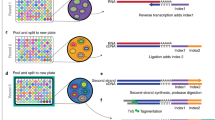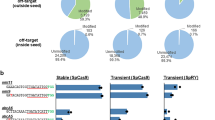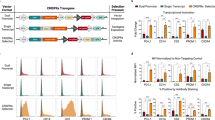Abstract
Nuclear proteins have essential roles in cell proliferation and differentiation. We have developed a yeast selection system—the nuclear transportation trap (NTT)—to identify genes encoding nuclear transport signals. Both unknown and previously identified nuclear localization signals were identified from a human fetal brain cDNA library. The majority (75%) of the unknown proteins examined were exclusively localized to the nucleus in COS-7 cells. We propose that NTT is an efficient method for isolating cDNAs that encode nuclear targeted proteins that can be applied to the retrieval of novel nuclear proteins and to annotate gene function.
This is a preview of subscription content, access via your institution
Access options
Subscribe to this journal
Receive 12 print issues and online access
$209.00 per year
only $17.42 per issue
Buy this article
- Purchase on Springer Link
- Instant access to full article PDF
Prices may be subject to local taxes which are calculated during checkout



Similar content being viewed by others
References
Görlich, D., and Mattaj, I.W. 1996 . Nucleocytoplasmic transport. Science 271: 1513–1518.
Nigg, E.A. 1997. Nucleocytoplasmic transport: signals, mechanisms and regulation . Nature 386: 779–787.
Ullman, K.S., Powers, M.A., and Forbes, D.J. 1997. Nuclear export receptors: from importin to exportin. Cell 90: 967– 970.
Pemberton, L.F., Blobel, G., and Rosenblum, J.S. 1988. Transport routs through the nuclear pore complex. Curr. Opin. Cell Biol. 10: 392–399.
Wozniak, R.W., Rout, M.P., and Aitchison, J.D. 1988. Karyopherins and kissing cousins. Trends Cell Biol. 8: 184– 188.
Ohno, M., Fornerod, M., and Mattaj, I.W. 1998. Nucleocytoplasmic transport: the last 200 nanometers. Cell 92: 327– 336.
Doye, V. and Hurt, E. From nucleoporins to nuclear pore complexes . 1997. Curr. Opin. Cell Biol. 9: 401–411.
Brent, R. and Ptashne, M. 1985. A eukaryotic transcriptional activator bearing the DNA specificity of a prokaryotic repressor . Cell 43: 729–736.
Ma, J. and Ptashne, M. 1987. Deletion analysis of GAL4 defines two transcriptional activating segments. Cell 48: 847–853.
Wen, W., Meinkoth, J.L., Tsien, R.Y., and Taylor, S.S. 1995. Identification of a signal for rapid export of proteins from the nucleus. Cell 82: 463– 473.
Estojak, J., Brent, R., and Golemis, E.A. 1995. Correlation of two-hybrid affinity data with in vitro measurements. Mol. Cell Biol. 15: 5820–5829.
Hoshino, T. and Kose K. 1989. Cloning and nucleotide sequence of braC, the structural gene for the leucine, isoleucine, and valine-binding protein of Pseudomonas aeruginosa PAO. J. Bacteriol. 171: 6300–6306.
Tokumitsu, H., Enslen, H., and Soderling, T.R. 1995. Characterization of a Ca2+/calmodulin-dependent protein kinase cascade. Molecular cloning and expression of calcium/calmodulin-dependent protein kinase kinase. J. Biol. Chem. 270: 19320–19324.
Ganchi, P.A., Sun, S.C., Greene, W.C., and Ballard, D.W. 1992 . I kappa B/MAD-3 masks the nuclear localization signal of NF-kappa B p65 and requires the transactivation domain to inhibit NF-kappa B p65 DNA binding. Mol. Biol. Cell 3: 1339– 1352.
Tratner, I. and Verma, I.M. 1991. Identification of a nuclear targeting sequence in the Fos protein. Oncogene 6: 2049–2053.
Stade, K., Ford, C.S., Guthrie, C., and Weis, K. 1997. Exportin 1 (Crm1p) is an essential nuclear export factor. Cell 90: 1041–1050.
Stutz, F., Neville, M., and Rosbash, M. 1995. Identification of a novel nuclear pore-associated protein as a functional target of the HIV-1 rev protein in yeast. Cell 82: 495–506 .
Altschul, S.F., Gish, W., Miller, W., Myers, E.W., and Lipman, D.J. 1990. Basic local alignment search tool. J. Mol. Biol. 215: 403– 410.
Landschulz, W.H., Johnson, P.F., and McKnight, S.L. 1988. The leucine zipper: a hypothetical structure common to a new class of DNA binding proteins. Science 240: 1759–1764.
Lupas, A. 1996. Coiled coils: new structures and new functions. Trends Biochem. Sci. 21: 375–382.
Fagotto, F., Gluck, U., and Gumbiner, B.M. 1998. Nuclear localization signal-independent and importin/karyopherin-independent nuclear import of beta-catenin. Curr. Biol. 8: 181–190.
Shimizu, K., Shirataki, H., Honda, T., Minami, S., and Takai, Y. 1998. Complex formation of SMAP/KAP3, a KIF3A/B ATPase motor-associated protein, with a human chromosome-associated polypeptide. J. Biol. Chem. 273: 6591– 6594.
Peifer, M., Berg, S., and Reynolds, A.B. 1994. A repeating amino acid motif shared by proteins with diverse cellular roles. Cell 76: 789–791.
Riggleman, B., Wieschaus, E., and Schedl, P. 1989. Molecular analysis of the armadillo locus: uniformly distributed transcripts and a protein with novel internal repeats are associated with a Drosophila segment polarity gene. Genes Dev. 3: 96–113.
Weis, K., Ryder, U., and Lamond, A.I. 1996. The conserved amino-terminal domain of hSRP1 alpha is essential for nuclear protein import. EMBO J. 15: 1818–1825.
Görlich, D., Henklein, P., Laskey, R.A., and Hartmann, E. 1996. A 41 amino acid motif in importin-alpha confers binding to importin-beta and hence transit into the nucleus. EMBO J. 15: 1810–1817.
Cortes, P., Ye, Z.S., and Baltimore, D. 1994. RAG-1 interacts with the repeated amino acid motif of the human homologue of the yeast protein SRP1 . Proc. Natl. Acad. Sci. USA 91: 7633– 7637.
Sekimoto, T., Imamoto, N., Nakajima, K., Hirano, T., and Yoneda, Y. 1997. Extracellular signal-dependent nuclear import of Stat1 is mediated by nuclear pore-targeting complex formation with NPI-1, but not Rch1. EMBO J. 16: 7067–7077.
Conti, E., Uy, M., Leighton, L., Blobel, G., and Kuriyan, J. 1998. Crystallographic analysis of the recognition of a nuclear localization signal by the nuclear import factor karyopherin alpha. Cell 94: 193– 204.
Michael, W.M., Eder, P.S., and Dreyfuss, G. 1997. The K nuclear shuttling domain: a novel signal for nuclear import and nuclear export in the hnRNP K protein . EMBO J. 16: 3587–3598.
Ferrari, S., Battini, R., Kaczmarek, L., Rittling, S., Calabretta, B., de Riel, J.K. et al. 1986. Coding sequence and growth regulation of the human vimentin gene. Mol. Cell. Biol. 6: 3614–3620.
MacLeod, A.R., Houlker, C., Reinach, F.C., and Talbot, K. 1986. The mRNA and RNA-copy pseudogenes encoding TM30nm, a human cytoskeletal tropomyosin. Nucleic Acids Res. 14: 8413–8426.
Tanaka, T., Inazawa, J., and Nakamura, Y. 1996. Molecular cloning and mapping of a human cDNA for cytosolic malate dehydrogenase (MDH1). Genomics 32: 128–130.
Bach, I., Carriere, C., Ostendorff, H.P., Andersen, B., and Rosenfeld, M.G. 1997. A family of LIM domain-associated cofactors confer transcriptional synergism between LIM and Otx homeodomain proteins. Genes Dev. 11: 1370–1380.
Tsuboi, A., Muramatsu, M., Tsutsumi, A., Arai, K., and Arai, N. 1994. Calcineurin activates transcription from the GM-CSF promoter in synergy with either protein kinase C or NF-kappa B/AP-1 in T cells. Biochem. Biophys. Res. Commun. 199: 1064–1072.
Wente, S.R., Rout, M.P., and Blobel, G. 1992. A new family of yeast nuclear pore complex proteins. J. Cell Biol. 119: 705–723.
Lupas, A. 1996. Prediction and analysis of coiled-coil structures. Methods Enzymol. 266: 513–525.
Acknowledgements
We thank the staff at HRI for supporting our work, and M.B. Swindells for comments regarding the manuscript.
Author information
Authors and Affiliations
Corresponding author
Rights and permissions
About this article
Cite this article
Ueki, N., Oda, T., Kondo, M. et al. Selection system for genes encoding nuclear-targeted proteins. Nat Biotechnol 16, 1338–1342 (1998). https://doi.org/10.1038/4315
Received:
Accepted:
Issue Date:
DOI: https://doi.org/10.1038/4315
This article is cited by
-
An iNTT system for the large-scale screening of differentially expressed, nuclear-targeted proteins: cold-treatment-induced nucleoproteins in Rye (Secale cereale L.)
BMC Genomics (2016)
-
Moonlighting transcriptional activation function of a fungal sulfur metabolism enzyme
Scientific Reports (2016)
-
bZIP10-LSD1 antagonism modulates basal defense and cell death in Arabidopsis following infection
The EMBO Journal (2006)
-
A genetic approach to identifying mitochondrial proteins
Nature Biotechnology (2003)
-
A genetic system for detection of protein nuclear import and export
Nature Biotechnology (2000)



